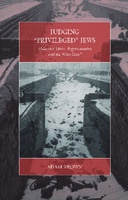Explore

The Nazis’ persecution of the Jews during the Holocaust included the creation of prisoner hierarchies that forced victims to cooperate with their persecutors. Many in the camps and ghettos came to hold so-called “privileged” positions, and their behavior has often been judged as self-serving and harmful to fellow inmates. Such controversial figures constitute an intrinsically important, frequently misunderstood, and often taboo aspect of the Holocaust. Drawing on Primo Levi’s concept of the “grey zone,” this study analyzes the passing of moral judgment on “privileged” Jews as represented by writers, such as Raul Hilberg, and in films, including Claude Lanzmann’s Shoah and Steven Spielberg’s Schindler’s List. Negotiating the problems and potentialities of “representing the unrepresentable,” this book engages with issues that are fundamental to present-day attempts to understand the Holocaust and deeply relevant to reflections on human nature.
This book is included in DOAB.
Why read this book? Have your say.
You must be logged in to comment.
Rights Information
Are you the author or publisher of this work? If so, you can claim it as yours by registering as an Unglue.it rights holder.Downloads
This work has been downloaded 150 times via unglue.it ebook links.
- 150 - pdf (CC BY-NC-ND) at OAPEN Library.
Keywords
- Auschwitz concentration camp
- Claude Lanzmann
- Collaboration
- Czerniaków
- History
- Holocaust ethics
- Jewish Studies
- Jews
- Judenrat
- Nazism
- Primo Levi
- Raul Hilberg
- Religious groups: social & cultural aspects
- Social groups
- Society & culture: general
- Society & Social Sciences
- Sonderkommando
- The Holocaust
- thema EDItEUR::5 Interest qualifiers::5P Relating to specific groups and cultures or social and cultural interests::5PG Relating to religious groups::5PGJ Relating to Jewish people and groups
- thema EDItEUR::J Society and Social Sciences::JB Society and culture: general::JBS Social groups, communities and identities::JBSR Social groups: religious groups and communities
Links
DOI: 10.2307/j.ctt9qd04wEditions

